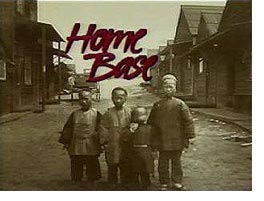Heinlenville Chinatown
Heinlenville, San Jose
Heinlenville, one of six Chinatowns in San Jose, was built in 1887. When an earlier Chinese settlement at the present site of the San Jose Fairmont Hotel was destroyed by a suspicious fire in the 1887, John Heinlen, a local businessman, braved death threats to lease property to the displaced Chinese. This area near today’s Japantown at Taylor and Sixth became known as Heinlenville.
Heinlenville was a center of Chinese-American business and cultural life through the early part of the 20th century. Despite their poverty, the people of Heinlenville donated their earnings from menial jobs to build their much revered Ng Shing Gung, a community center and house of worship.
Originally, a fence surrounding Heinlenville was locked every night to protect the inhabitants. Eventually the community grew to about two thousand; and as the town thrived, the gates could remain open. The crossing of the moongate that opened the 1994 Chinese Summer Festival symbolized the opening of the Heinlenville gates to bring together people of different ethnic backgrounds.
By the 1930s, many of Heinlenville’s original residents had passed on. Their children had grown up and integrated into the community at large, and the Chinese Exclusion Act had prevented new arrivals from China. When the Heinlenville estate declared bankruptcy, Heinlenville became the property of the City of San Jose, which razed the area with the exception of the Ng Shing Gung.
![[Image: ngshing_small]](http://archive.chcp.org/wp-content/uploads/2014/01/ngshing_small.jpg) Despite the objections of Clyde Arbuckle and other local historians, this last remnant of Heinlenville, was dismantled in 1949. In 1991, this piece of history was recovered, when the Ng Shing Gung was replicated and dedicated to the community by the Chinese Historical and Cultural Project.
Despite the objections of Clyde Arbuckle and other local historians, this last remnant of Heinlenville, was dismantled in 1949. In 1991, this piece of history was recovered, when the Ng Shing Gung was replicated and dedicated to the community by the Chinese Historical and Cultural Project.
 The 1995 Chinese Summer Festival marked the presentation of the first annual Heinlen Award, commemorating John Heinlen by recognizing an individual who promotes cultural diversity. The first recipient was Dave Thomas, owner and founder of the East West Kung Fu School. Dave’s interest in the art and culture of Asia is evident in his enthusiasm, which spearheaded the reconstruction of the Golden Dragon.
The 1995 Chinese Summer Festival marked the presentation of the first annual Heinlen Award, commemorating John Heinlen by recognizing an individual who promotes cultural diversity. The first recipient was Dave Thomas, owner and founder of the East West Kung Fu School. Dave’s interest in the art and culture of Asia is evident in his enthusiasm, which spearheaded the reconstruction of the Golden Dragon.
More information about Heinlenville is available by viewing the Ng Shing Gung exhibits and Homebase: A Chinatown Called Heinlenville, Jessica Yu’s award-winning video, which can be viewed here and at the Ng Shing Gung building in History Park. Home Base may also be ordered separately or as a part of the Golden Legacy curriculum for a donation. Complete and mail in the order form here.
 In depth background can be obtained in Connie Young Yu’s Chinatown, San Jose, USA, originally published by the San José Historical Museum Association (now History San José). The book is available online (shop at AmazonSmile.com to fundraise for CHCP), at the gift shop at History Park San Jose, and in various branches of the San Jose Public Library.
In depth background can be obtained in Connie Young Yu’s Chinatown, San Jose, USA, originally published by the San José Historical Museum Association (now History San José). The book is available online (shop at AmazonSmile.com to fundraise for CHCP), at the gift shop at History Park San Jose, and in various branches of the San Jose Public Library.
Upcoming Events
The Chinese Historical and Cultural Project | info@chcp.org | © Copyright 1996-2026. All rights reserved.


